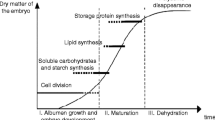Abstract
The importance of fast-trackt generation advancement in developing superior germplasm has been recognized in breeding of many crop species. To address this issue in tomato, immature seeds were excised from fruit at different maturity stages and transferred to culture medium. The best culture medium was modified full strength Moorashige–Skoog (MS) salts supplemented with 0.1 mg l−1 IAA, 0.5 mg l−1 IBA, 0.5 mg l−1 GA3 and 2% sucrose. If the excised seeds were able to grow, most showed shoot formation after a week. Seeds extracted as early as 10 days after pollination were successfully cultured provided they were transferred aseptically and without injury. No morphological or physiological changes in regenerated plants and their fruit relative to the parent were detected. Germination from immature seeds of tomato is a simpler alternative to in vitro culture of immature embryos or callus, as it can be undertaken in comparatively less stringent laboratory conditions. Using this approach, five generations can be produced in a year in contrast to a maximum of three generations with conventional methods. This offers an opportunity for rapid generation advancement aimed towards population development when coupled with marker assisted selection in tomato breeding for biotic and abiotic stress tolerance.



Similar content being viewed by others
References
Ashby E (1937) The determination of size in plants. Proc Linn Soc Lond 149:2
Barbano PP, Topolesky LD (1984) Post fertilization hybrid seed failure in Lycopersicon esculentum × Lycopersicon peruvianum ovules. J Am Soc Hortic Sci 109:95–100
Chen L, Adachi T (1992) Embryo abortion and efficient rescue in interspecific hybrids Lycopersicon esculentum and the peruvianum complex. Jpn J Breed 42:65–77
Cong B, Liu J, Tanksley SD (2002) Natural alleles at a tomato fruit size quantitative trait locus differs by heterochronic regulatory mutations. PNAS 99(21):13606–13611
Demir I, Samit Y (2001) Quality of tomato seed as affected by fruit maturity at harvest and seed extraction method. Gartenbau 66(4):199–202
Demirel F, Seniz V (1997) A research on the utilization possibilities of embryo culture in tomato (lycopersicon esculentum mill.). Acta Hortic (ISHS) 447:237–238. http://www.actahort.org/books/447/447_49.htm
Dias DCFS, Ribeiro FP, Dias LAS, Silva DJH, Vidigal DS (2006) Tomato seed quality in relation to fruit maturation and post harvest storage. Seed Sci Tech 34(3):691–699
Domoradzki M, Korpal W (2005) Seed size dependent germination of selected vegetable. Acta Agrophysica 5(3):607–612
Engle LM, Shanmugasundaram S, Hanson P (2003) Evaluation and utilization of vegetable genetic resources for the tropics. Acta Hortic 623:263–274
Finch-Savage WE, Leubner-Metzger G (2006) Seed dormancy and control of germination. New Phytol 171:501–523
Hocher V, Sotta B, Maldiney R, Bonnet M, Miginiac E (1992) Changes in indole-3-acetic acid levels during tomato (Lycopersicon esculentum Mill.) seed development. Plant Cell Rep 11(5–6):253–256
Imanishi S, Hiura I (1975) Relationship between fruit weight and seed content on tomato. J Jpn Soc Hortic Sci 44(1):33–40
Jones JB (2007) Tomato plant culture in the field, glasshouse and home garden, 2nd edn. CRC Press, Boca Raton, p 337
Luckwill LC (1939) The factors affecting the mean seed weight of tomato fruits. New Phytol 38(3):181–189
Lumpkin H (2005) A comparison of lycopene and other phytochemicals in tomatoes grown under conventional and organic management systems. Technical Bulletin No. 34. AVRDC Publication Number 05–623. Shanhua, Taiwan: AVRDC—The World Vegetable Center: 48
Mallikarjuna N (1999) Ovule and embryo culture to obtain hybrids from interspecific incompatible pollinations in chickpea. Euphytica 110:1–6
Mobayen RG (1980) Germination and emergence of citrus and tomato seeds in relation to temperature. J Hortic Sci 55:291–297
Murashige T, Skoog F (1962) A revised medium for rapid growth and bioassays with tobacco tissue cultures. Physiol Plant 15(3):473–497
Picken AJF, Stewart K, Klapwijk D et al (1986) Germination and vegetative development. In: Atherton JG, Rudich J (eds) The tomato crop—a scientific basis for improvement. Chapman & Hall, New York, pp 111–131
Pico B, Herraiz J, Ruiz JJ, Nuez F (2002) Widening the genetic basis of virus resistance in tomato. Sci Hortic 94:73–89
Polanco MC, Ruiz ML (2001) Factors that affect plant regeneration from in vitro culture of immature seeds in four lentil cultivars. Plant Cell Tiss Org Cult 66:133–139
Poysa V (1990) The development of bridge lines for interspecific gene transfer between Lycopersicon esculentum and Lycopersicon peruvianum. Theor Appl Genet 79:187–192
Rao RGS, Singh PM, Rai M (2008) Effect of seed maturity and priming on viability and vigour in tomato (Lycopersicon esculentum L.). Eur J Hortic Sci 73:56–63
Sokal RR, Rohlf FJ (1987) Introduction to biostatistics, 2nd edn. WH Freeman and Company, New York
Torresan A, Kesteloot J, Castano F, Rodriguez R, Colabelli M (1996) Use of immature seed germination technique as an alternative to in vitro culture of sunflower (Helianthus annuus L.) embryos. Euphytica 91(1):1–3
Vikrant, Rashid A (2002) Somatic embryogenesis from immature and mature embryos of a minor millet Paspalum scrobiculatum L. Plant Cell Tiss Org Cult 69:71–77
Whittington WJ, Fierlinger P (1972) The genetic control of time to germination in tomato. Ann Bot 36:873–880
Acknowledgments
We would like to thank Ms. Jean Lin, Mr. Allen Hsu, Dr. Rachael Symonds, and Ms. Julie Chu of AVRDC-The World Vegetable Center for their assistance. We are thankful to Editor Prof Adam J. Lukaszewski for his constructive comments, suggestions and contributions. The research was funded by an Australian Government, DEST, Endeavour Fellowship granted to Dr Surya P. Bhattarai.
Author information
Authors and Affiliations
Corresponding author
Rights and permissions
About this article
Cite this article
Bhattarai, S.P., de la Pena, R.C., Midmore, D.J. et al. In vitro culture of immature seed for rapid generation advancement in tomato. Euphytica 167, 23–30 (2009). https://doi.org/10.1007/s10681-008-9855-6
Received:
Accepted:
Published:
Issue Date:
DOI: https://doi.org/10.1007/s10681-008-9855-6




